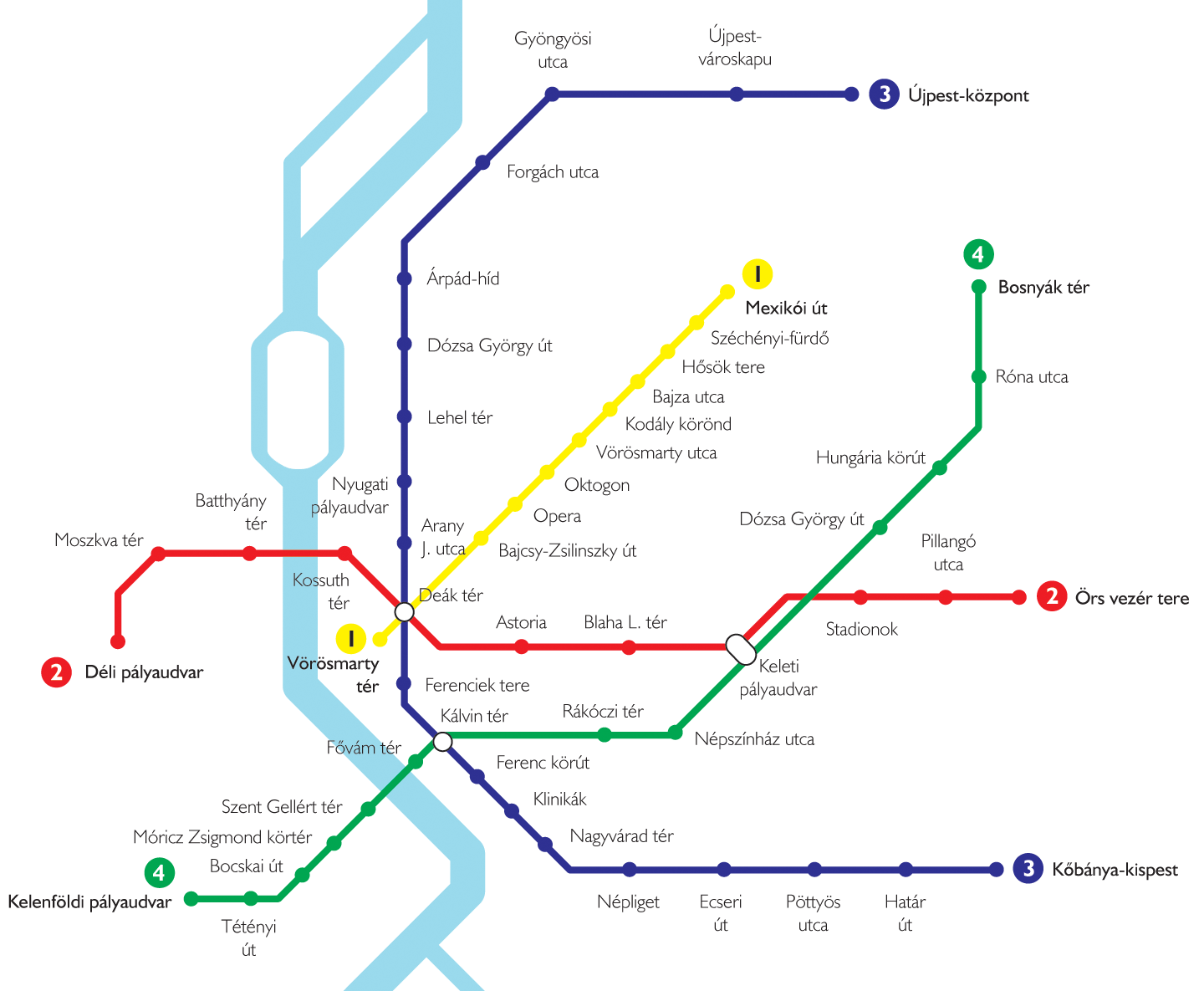
The metro lines of Budapest
Like most capitals and metropolises, Budapest is equipped with a number of metro lines to help locals and tourists get around the city fast. In the case of the Hungarian capital, there are four metro lines to accommodate your transit needs and reach the city center even from several suburban areas. Read on to get to know each of Budapest’s metro lines, their history, and where they can take you.
O
C
Metro line 1 (yellow line)
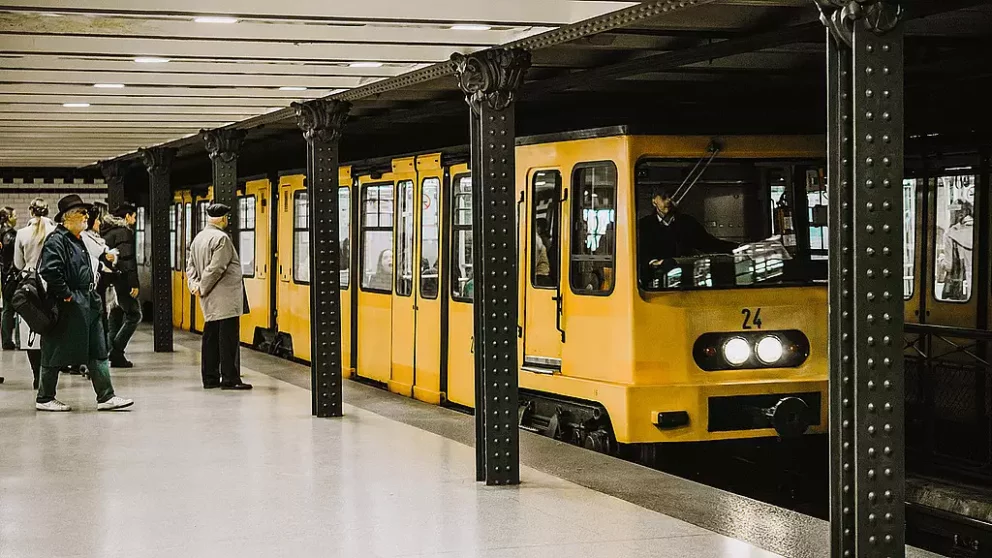
Opened in 1896, metro line 1, or ‘kisföldalatti’ (literally ‘little underground’) as the locals call it, was the first metro line to be built in the Hungarian capital, as well as in continental Europe. And there is a reason it’s called little underground – although perfectly renovated and modernized, the little yellow cars of this line look like they’re straight out of a toy box; and it’s so close to the surface, when you walk Andrássy Avenue, you can easily tell when the metro passes under the sidewalk from the vibrations it causes.
Stops
Metro line 1 connects Budapest’s tourist center, Vörösmarty tér (where the Christmas Market takes place every year) with Mexikói út, essentially running below the whole of Andrássy Avenue (which is one of the city’s most beautiful roads and home to a number of popular luxury stores), Heroes’ Square, and Városliget (City Park).
- Vörösmarty tér
- Deák Ferenc tér (Transfer to metro lines 2 & 3)
- Bajcsy–Zsilinszky út
- Opera
- Oktogon (Transfer to tram 4-6)
- Vörösmarty utca
- Kodály körönd
- Bajza utca
- Hősök tere (Heroes’ Square)
- Széchenyi fürdő (Széchenyi Bath)
- Mexikói út
It’s safe to say the ‘kisföldalatti’, as well as nearly all the stops it serves, should be at the top of your Budapest to-do list.
Metro line 2 (red line)

More than seven decades after metro line 1 started transporting passengers, metro line 2 was set in operation in 1970. The opening of the ‘red line’ was an important step in the history of Budapest’s transport system, as this metro line connected Buda and Pest, making it easy and quick to commute across the Danube for locals. It also remained the only metro line to connect the two parts of the city until 2014, when the green line was finished.
Stops
Metro line 2 runs across a big part of the city horizontally connecting Déli and Keleti railway stations, and makes a stop at Deák Ferenc tér, which is the city’s most important and central transport hub.
- Déli pályaudvar (Déli Railway Station)
- Széll Kálmán tér (Transfer to tram 4-6)
- Batthyány tér
- Kossuth Lajos tér (Parliament – transfer to tram 2, one of the most scenic transport lines in the world)
- Deák Ferenc tér (Transfer to metro lines 1 & 3)
- Astoria
- Blaha Lujza tér (Transfer to tram 4-6)
- Keleti pályaudvar (Keleti Railway Station)
- Puskás Ferenc Stadion ♿
- Pillangó utca ♿
- Örs vezér tere ♿
In addition to two of the capital’s major railway stations and a number of busy transit centers, metro line 2 also serves Kossuth tér, which is where the Parliament is situated, making it an absolute must-ride for tourists.
Metro line 3 (blue line)
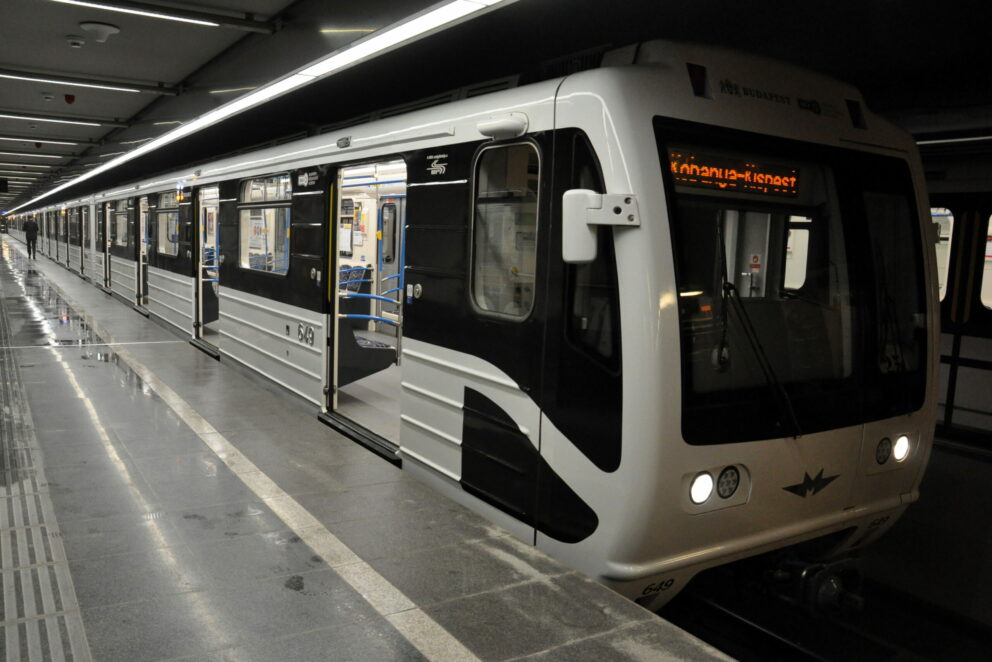
Shortly after the opening of the red line, metro line 3 opened its gates in 1976 and remained the ‘latest’ metro line for almost 40 years. Although now it looks all modern and neat, it wasn’t always the case. As decades went by and the older metro lines got renovated, even though metro line 3 was the most recent of Budapest’s metro lines, it seemed the oldest for a very long time. For many decades, the cars and stations on the ‘blue metro line’ greeted passengers with a neglected, post-Soviet era look, which some might have possibly called nostalgic, but it certainly didn’t make a good first impression on most people. Thankfully, renovations started a few years ago, but as it’s the longest metro line, they’re carried out in separate phases and are still in progress. Unfortunately, this means that some sections of the line are always closed down and served by replacement buses. For the most up-to-date information, refer to BKK’s website.
Stops
Metro line 3 runs across the Pest side of town serving a staggering 20 stops and carrying a huge number of passengers north to south and vice versa every day.
- Kőbánya-Kispest ♿
- Határ út
- Pöttyös utca
- Ecseri út
- Népliget ♿
- Nagyvárad tér
- Semmelweis Klinikák
- Corvin-negyed (Transfer to tram 4-6)
- Kálvin tér (Transfer to metro line 4)
- Ferenciek tere
- Deák Ferenc tér (Transfer to metro lines 1 & 2)
- Arany János utca
- Nyugati pályaudvar (Nyugati Railway Station – transfer to tram 4-6)
- Lehel tér
- Dózsa György út
- Göncz Árpád városközpont ♿
- Forgách utca ♿
- Gyöngyösi utca ♿
- Újpest-városkapu ♿
- Újpest-központ ♿
Metro line 3 is also your go-to transit line if you want to reach or leave Budapest Airport by public transportation. Read more on your airport transfer option here.
Metro line 4 (green line)
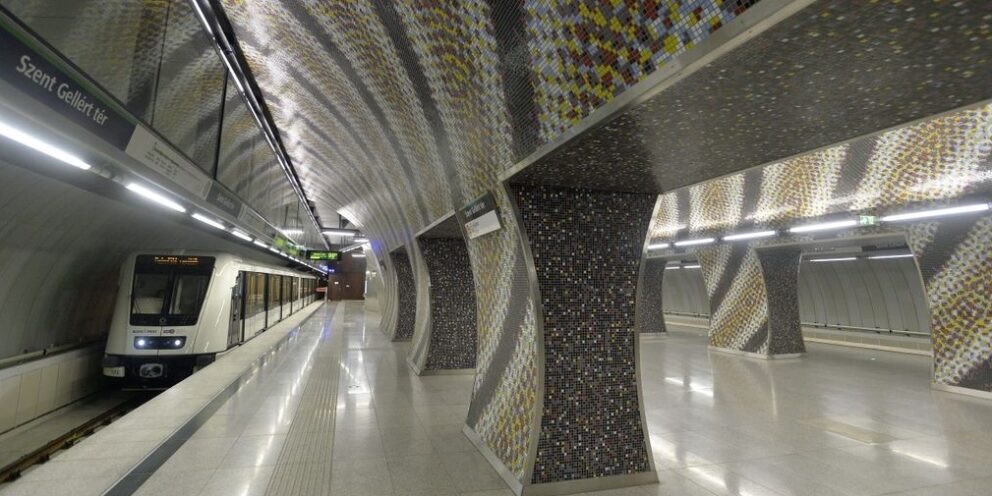
Opened in 2014, metro line 4 is the latest addition to Budapest’s metro network, and the only metro line apart from line 2 that connects Buda and Pest. With one of its terminuses in Kelenföld, metro line 4 fulfilled a long-awaited need to connect the southern parts of Buda with the city center and thus received a warm welcome by those living or working in Újbuda. It’s also worth noting the infamously long time it took to build this metro line. Although the first construction plans were developed in 1972, works didn’t begin until 2004, and even after that they took 10 years to complete. In total, metro line 4 took more than four decades to be built and its construction was widely criticized for being slow, incompetent, and suspicious of government corruption.
Stops
Metro line 4 connects Keleti Railway Station with Kelenföld Railway Station. The green line is the only metro line in Budapest that doesn’t stop at Deák Ferenc tér. Instead, transfer to 2 of the other 3 metro lines is available at Kálvin tér (metro line 3) and Keleti pályaudvar (metro line 2).
- Kelenföld vasútállomás ♿ (Kelenföldi Railway Station)
- Bikás park ♿
- Újbuda-központ ♿ (Transfer to tram 4)
- Móricz Zsigmond körtér ♿ (Transfer to tram 6)
- Szent Gellért tér – Műegyetem ♿
- Fővám tér ♿
- Kálvin tér ♿ (Transfer to metro line 3)
- Rákóczi tér ♿ (Transfer to tram 4-6)
- II. János Pál pápa tér ♿
- Keleti pályaudvar ♿ (Keleti Railway Station – Transfer to metro line 2)
While most stops of this line don’t coincide with major attractions in the city, stops like the busy Keleti Railway Station, the bustling Kálvin tér, and the majestic Szent Gellért tér, where one of the most beautiful hotels of the city is located, all make it worth hopping on the green line for one thing or another.
Transport fares
All metro lines are accessible using single tickets which allow you to transfer to another metro line during your trip (350 HUF – roughly €1), 3-stop-only section tickets (300 Ft – roughly 80 eurocents), and multi-day passes. For more information, check out BKK’s website.
Stay online on all lines

Although most Hungarians have no idea this is a big thing to residents of many other cities, there is awesome mobile network reception on all metro lines, no matter how far below the ground they are. Texting? Not a problem. Phone calls? As you wish. Watching videos on social media? You got it. In fact, if want to have fast and reliable internet connection for you and your friends during your stay, but don’t want to bother with SIM cards, we know just what you need. Check out our article on Budapest Wi-Fi for more information.
Learn more on transportation in Budapest
f you want to find out more on how to get around the city, our article will tell you everything you’ll need to know. You can also head over to the website of Budapest’s transportation company, BKK. You’ll find timetables, general info on metro, tram, bus and trolleybus lines, and important service updates. We also recommend you download the BKK Futár app (available for both Android devices and iPhones), which lets you check real-time vehicle information such as arrival times and wheelchair accessibility, and plan your trips in the city conveniently.
Q&A
- Does Budapest have metro lines?
Yes, Budapest has four metro lines to accommodate the needs of the city’s residents and visitors.
- How many metro lines are there in Budapest?
Budapest has four metro lines, making the city center quickly and easily accessible to most parts of the city.
- What is the oldest metro line in Budapest?
Opened in 1896, metro line 1 (the yellow one) was the first metro line to be built in Budapest, as well as continental Europe.






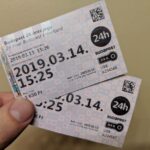

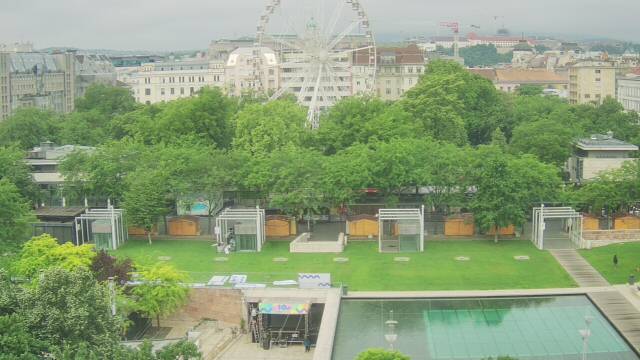
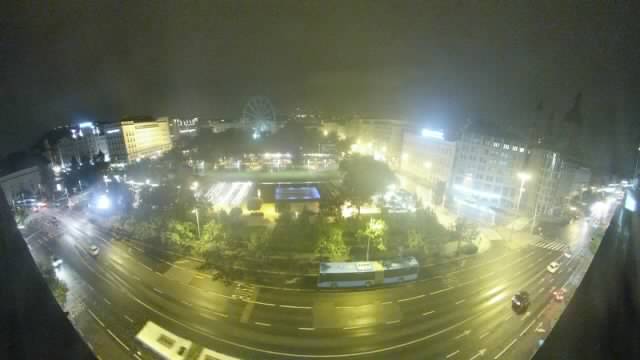
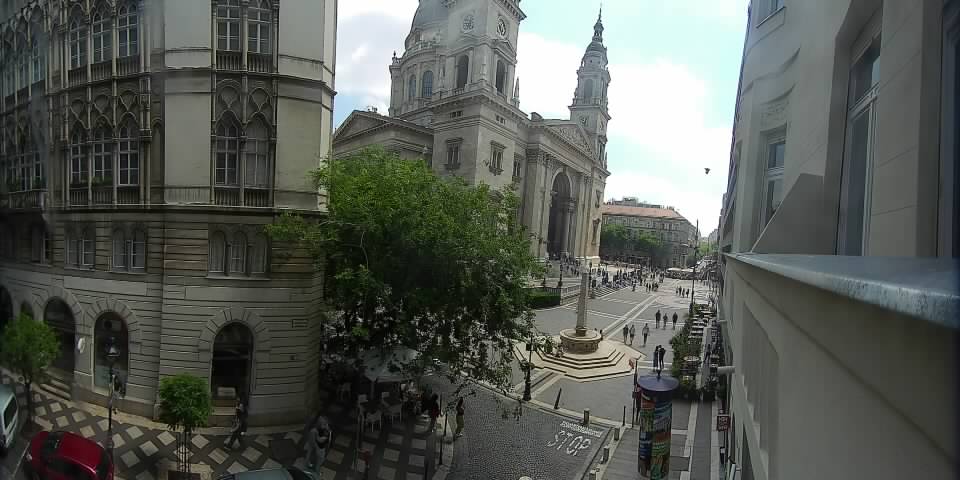

Your experience is important.
Anything you have not found?
Ask a Question
Please log in to write a review.
There is no review yet.